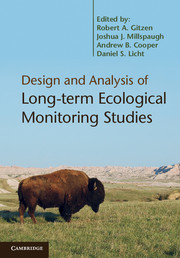Book contents
- Frontmatter
- Contents
- List of contributors
- Foreword: Ecology, management, and monitoring
- Preface
- Acknowledgments
- Abbreviations
- Section I Overview
- Section II Survey design
- Section III Data analysis
- Section IV Advanced issues and applications
- 16 GRTS and graphs
- 17 Incorporating predicted species distribution in adaptive and conventional sampling designs
- 18 Study design and analysis options for demographic and species occurrence dynamics
- 19 Dealing with incomplete and variable detectability in multi-year, multi-site monitoring of ecological populations
- 20 Optimal spatio-temporal monitoring designs for characterizing population trends
- 21 Use of citizen-science monitoring for pattern discovery and biological inference
- Section V Conclusion
- References
- Index
- Plate Section
21 - Use of citizen-science monitoring for pattern discovery and biological inference
Published online by Cambridge University Press: 05 July 2012
- Frontmatter
- Contents
- List of contributors
- Foreword: Ecology, management, and monitoring
- Preface
- Acknowledgments
- Abbreviations
- Section I Overview
- Section II Survey design
- Section III Data analysis
- Section IV Advanced issues and applications
- 16 GRTS and graphs
- 17 Incorporating predicted species distribution in adaptive and conventional sampling designs
- 18 Study design and analysis options for demographic and species occurrence dynamics
- 19 Dealing with incomplete and variable detectability in multi-year, multi-site monitoring of ecological populations
- 20 Optimal spatio-temporal monitoring designs for characterizing population trends
- 21 Use of citizen-science monitoring for pattern discovery and biological inference
- Section V Conclusion
- References
- Index
- Plate Section
Summary
Introduction
Citizen science, broadly speaking, is the involvement of amateur (i.e. unpaid, but not necessarily unskilled) participants in the process of scientific studies, typically with data collection or data processing (Cooper et al. 2007, Silvertown 2009). The benefits of citizen-science monitoring programs for public engagement and education are often emphasized (Chapter 23), but here we focus on programs sharing the same primary motivation as those discussed in the rest of this volume: obtaining data and information needed for managing and understanding ecological systems. Often, “amateur” monitoring may be the only or the most cost-effective approach for obtaining such information. For example, an important role for citizen science in monitoring of animals or plants follows from the fact that identification of species is currently difficult or impossible to automate, although technological inroads are being made (e.g. Brower 2006, Sarpola et al. 2008). Thus, if the goal is to monitor over large geographical areas such as most or all of a species’ range, data will often need to be collected by a large number of people, and volunteer-dependent monitoring will be the only logistically feasible approach (with very few exceptions, e.g. Smith 1995).
While creating opportunities for monitoring, volunteer-based approaches also can introduce challenges for the design of studies and analyses of the resultant data (Box 21.1). Challenges are created by three common characteristics of data that come from citizen-science projects. First, the wide geographic and temporal scope of studies mean that attention must be paid to maintaining consistency in data-collection protocols and checking for potential spatial and temporal sources of bias. Second, data often must be collected using protocols that are potentially not as demanding of the data collectors as are protocols for professionally collected data. Third, data are often collected for surveillance monitoring and the general nature of such data may allow their re-use for multiple purposes, necessitating additional steps in analyses to investigate the possibility that biases exist for which the study design does not adequately control. Although we do not wish to imply that volunteer-collected data will always have these characteristics, we believe that these traits are present frequently enough in citizen-science monitoring to warrant their place in motivating the topics discussed in this chapter. In contrast, if data from a citizen-science project can be collected with a tightly controlled survey design and are well-suited to answering a focused question using a well thought out parametric statistical model or with a design-based analysis, then there is nothing to distinguish such a project from any other monitoring initiative discussed in this volume. Aside from issues discussed under Data Collection and Management, below, we will not discuss these “targeted” projects.
- Type
- Chapter
- Information
- Design and Analysis of Long-term Ecological Monitoring Studies , pp. 460 - 478Publisher: Cambridge University PressPrint publication year: 2012
- 4
- Cited by

